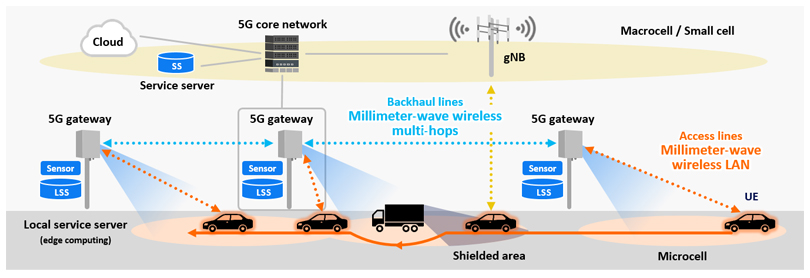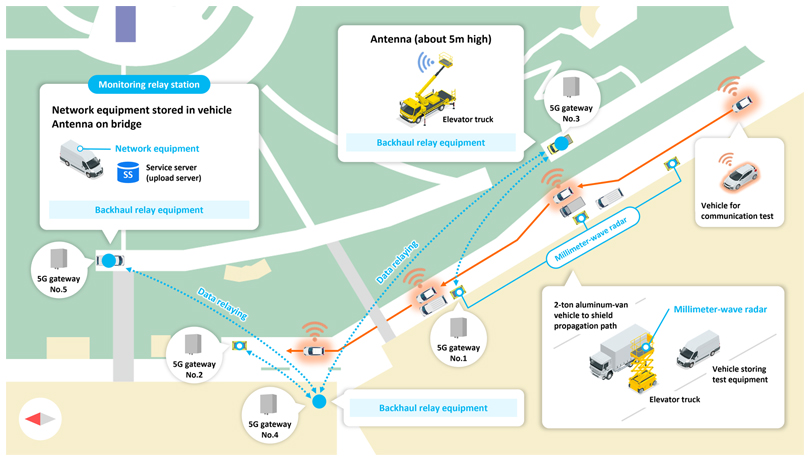Panasonic Connect and Yokohama City to Test World’s First Beyond-5G Network Demonstration Aimed at Automated-driving
New solutions for energy inefficiency of 5G networks and degraded transmission quality of millimeter-wave wireless LANs in shielded environments
TOKYO, JAPAN – Panasonic Connect Co., Ltd. and the City of Yokohama announced today their plan to demonstrate the world’s first Beyond 5G technologies1 for automated driving, developed by Panasonic Connect, with its sensing and wireless-quality-prediction technologies for switching from millimeter-wave wireless LANs (60GHz) to a 5G network at optimum timing for uninterrupted service. The demonstration will take place in the Rinko Park area of Yokohama, including park pathways and the surrounding area, from December 19 to 23.
The new system addresses the energy inefficiencies of 5G and other wireless communication networks by introducing millimeter-wave wireless LANs. Also, the problem of shielded (blocked) propagation paths degrading the transmission quality of millimeter-wave wireless LANs is solved by using sensing and wireless-quality-prediction technologies to identify potential degradation problems in advance.
Yokohama is working to help companies improve productivity, develop solutions for societal issues, and create new business models by using advanced technologies such as IoT and AI, including by supporting demonstration tests through its “I-TOP Yokohama”2 initiative. The demonstration of Panasonic Connect’s Beyond 5G technology has been organized under this initiative.
While 5G networks provide services that cover wide areas, they require large numbers of base stations due to the limited range of their radio waves, resulting in high energy consumption. In contrast, the millimeter-wave wireless LANs in the demonstration will use the 60GHz band, which requires relatively few wireless stations and thus encounters less chance of interference. Also, it can transmit gigabit-class throughput with high stability and energy efficiency due to its lower power consumption compared to 5G networks. However, the high linearity of millimeter waves leads to problems when propagation paths are blocked, so they have been used mainly for services in limited areas so far. The realization of millimeter-waves services for wide areas and mobility applications requires further technological development.
In the demonstration, the incorporation of millimeter-wave wireless LANs in a 5G network is expected to increase the energy efficiency of the overall network by a factor of three or more. Furthermore, the experiment is expected to demonstrate that millimeter-wave wireless LANs can switch to a 5G network (using Wi-Fi as a substitute for the network in the test) at optimal timing. This will be achieved with Panasonic Connect’s proprietary wireless-quality-prediction and sensing technologies to identify shielded environments in advance for uninterrupted communication required to support automated driving3. An area in which the propagation path is shielded will be created with a large stationery vehicle, which the sensing technology is expected to predict in advance, triggering the system to switch from the millimeter-wave wireless LAN to the 5G network. This will be the world’s first demonstration of sensing technology to detect objects (using a 79GHz millimeter-wave radar in the test) and wireless-quality-prediction technology to predict shielded environments.
If it becomes possible to control the instantaneous transmission and reception of large amounts of data for applications such as real-time video sharing for remote monitoring of automated vehicles as well as self-driving robots, and also for high-precision dynamic maps, the power-consumption efficiency of wireless network systems for automated driving is expected to improve significantly. Through the demonstration, Panasonic Connect hopes to identify potential issues and then implement necessary improvements aimed at realizing accelerated commercial application.
Panasonic Connect, guided by its mission of “Change Work, Advance Society, Connect to Tomorrow,” is committed to contributing to the realization of a sustainable society and to ensure well-being for all.
System configuration

Demonstration layout











